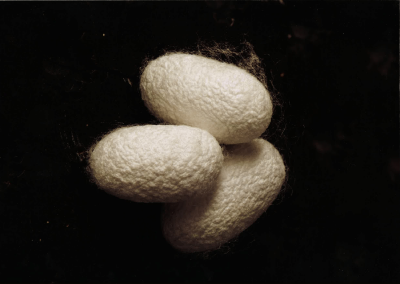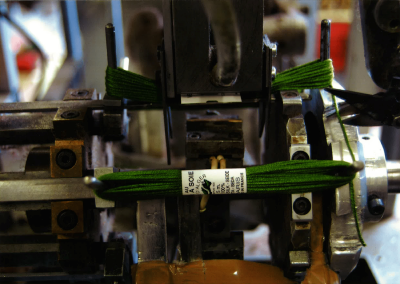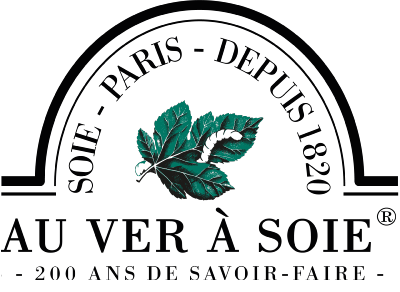Around Silk : Raising Silk Worms  1- Cultivation of mulberry bushes : Mulberry bushes prefer a temperate climate, but can be cultivated in a wide geographic zone extending from the Tropics to fairly cool climes. They are most widespread in the Far East (China, Japan, Korea, South East Asia), but are also found in South America (Brazil), the Near East and Europe (Greece, Italy, Spain and South East France). Soil type and favourable climate play a large role in the establishment of Mulberry bushes, of which there are 42 species. The principal species cultivated nowadays are Morus Latifolia, Morus Alba Linn and Morus Bombycis Koidz. For good leaf production, the mulberry needs to have multiple branches and stems for rapid growth. The best leaf is medium sized, thick, dark green, and covered with a little down. Tropical regions situated 600-700 metres above sea level offer the best conditions for year long mulberry cultivation, with the possibility of 8 harvests instead of the 2 which are normal in temperate zones.
2- Raising silk worms
Silk growers care for the silkworm moths like new born babies. Liu Tai Hseuh, of the Taiwanese Sericulture Improvement Station lists some of the dangers to which silk-worms are prey:
A) The eggs
The silkworm egg has an elliptical shape and is small and flat, covered with a hard membrane. The shape and size of the egg vary depending on the speicies. Its colour is milky white or a single shade of yellow. There are two sorts of egg, hibernating and non-hibernating. Throughout the laying, the ideal temperature is between 23- 25 degrees Celsius with a humidity level of around 75%-80%. Eggs which are laid by mid-June and hatch at the beginning of May following are subject to strict conservancy rules.
B) The Worm
The silk worm is an insect with a four stage life cycle - egg, larva, chrysalis, and butterfly. The eggs hatch a fortnight after the start of incubation. Larvae which are called Kego in Japanese mature after 4 dormant periods. Between each moult, the worm is ravenous with hunger. The life-span of the silk worm is about 25 days. Between its hatching and the time it spins its cocoon, its weight increases ten thousand fold and its size four thousand fold. After having eaten a large quantity of leaves during the first four life-stages, it stops eating at the fifth stage and attaches itself to a sprig of heather by a thread of silk which is ejected from a gland through a spinneret located under its lip. The diameter of this thread is around 30 microns and it takes 3,500 - 4,500metres to make one gram of silk. After 3 days, the worm metamorphoses into a chrysalis. Ten days later the chrysalis becomes a butterfly, which in order to release itself has to secrete alkaline saliva to dissolve one end of the cocoon.
3- Composition of silk :
A) The chemical composition of silk
The chemical composition of silk :
B) Qualities of silk
Under a microscope, a thread of raw silk looks like a glass tube perfectly smooth and clear, with no irregularities at all. This absolutely regular structure confers on silk its smooth look and feel, its lustre and brilliance. Parts of fibres less well organized, called amphorae, gives silk its elastic quality, its solidity, fineness, lightness and suppleness. Silk is imperishable. It has a great absorbency which means it dyes easily. Silk can absorb up to 30% of its weight in water without the fabric feeling damp. This gives silk its quality of unrivalled hygiene and comfort. It also offers protection against heat, cold, humidity and sweat. This invaluable material can be electrically charged with the least rubbing in dry air, which means it is a perfect electrical isolator.
C) How silk is recognized ?
On heating, silk burns and forms black, crumbly balls which smell of burning horn. Silk breaks down at 130 degrees Celsius and carbonises at around 300 degrees Celsius. A strand of conditioned silk stretches by 17% - 25% when dry and 30% when damp.
D) Classification of silk
There is a large variety of raw silks. Choice of silk depends on use and country of origin (Japan, Korea, China, Brasil, etc).
In each country, the silks are distinguished by their classification which designates in deniers the width of the thread. This system is used throughout the world. The most commonly used classifications today are 13/15, 20/22, 40/44 denier for raw silk destined for weaving, sewing thread and embroidery thread. Each classification is further graded: 6A, 5A, 4A, 3A, 2A, A, B, C, D, E, F, G etc. These gradings are applied to each lot after sorting in the country of origin. Grading depends on the regularity of the thread, cleanliness, neatness, variations in the lot, assays, breaking points, strength, elasticity, cohesion. The best system for grading silk is the Ulster Tester which provides assays with a 95% confidence level. This control system means that the number of grades can be reduced from 11 to 8.
Around Silk : To learn more |


